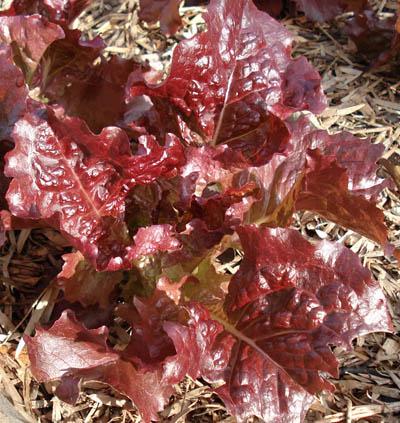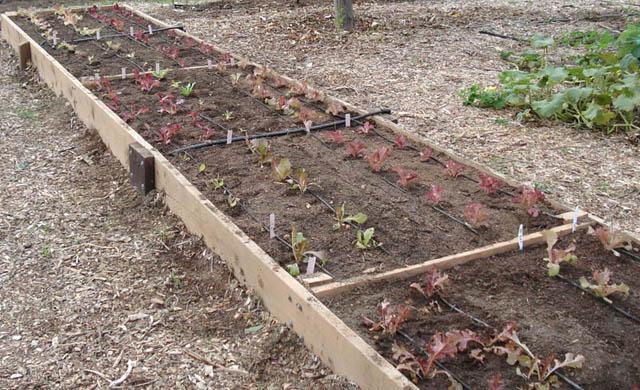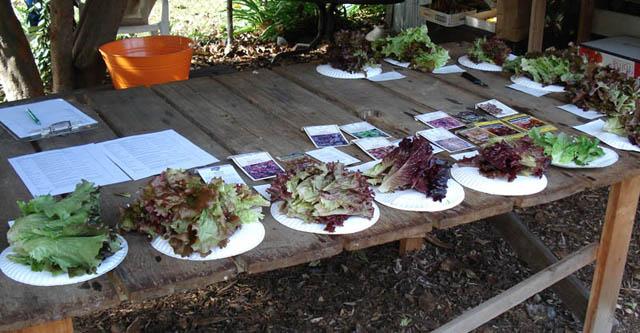Redleaf Looseleaf Lettuce Trial
Summary
We compared thirteen varieties of red looseleaf lettuce to determine the best production and taste. All of the varieties were very healthy and pretty to look at. Flame and Cardinale were judged the best at the tasting, Sunset and Bronze Arrow were tied for second and Susan’s Red Bibb was third. The very deepest red lettuce, Merlot, was judged to be tart or bitter.

Overview
We compared thirteen varieties of red looseleaf lettuce (Latin name, Lactuca sativa) to determine the best production and taste. We grew them in the winter, starting the seeds in September and harvesting the lettuce from November through February.
Soil preparation
A raised bed that had been used for cantaloupes was used. Well composted horse manure was added.
Seeding
On September 21, 2007, seeds were planted in six-packs. Two packs of each variety were planted (twelve plants of each). These were then placed in the shade house where they got watered daily by the overhead sprinklers. Within a week, they had germinated.
Transplanting
On October 25, 2007, the seedlings were transplanted into the raised bed with one handful of alfalfa pellets in each hole. The plants were spaced 8-10 inches apart. This spacing would allow us to harvest whole plants as well as cut leaves from the outside.

Watering
Watering was done by using the existing drip system set for three times a week for 30 minutes. On October 30th, a light mulch of wood chips was put down to control weeds and to keep the leaves cleaner.
Fertilization and Pesticides
No additional fertilizers or pesticides were used.
Harvesting/Tasting
The tasting took place on November 27th with about 14 Master Gardeners participating. As usual, tastings can be somewhat subjective. The following table shows some of the tasting comments.

| Variety | Description | Tasting notes (from multiple people) |
Seed source* |
|---|---|---|---|
| Bronze Arrow | Mild flavored California heirloom, red edged leaves | Slightly bitter, full-bodied, no taste, sweet, buttery, substantal | Seeds of Change |
| Cardinale | Thick, crisp brilliant red leaves on relatively upright plants | Rich taste, crisp, good, texture is crunchy | Swallowtail Garden Seeds |
| Flame | Distinctly red, introduced in 1988 by Harris Moran Seed Co. | Sweet, good taste, tender, sweet, like butter lettuce | Seed Savers Exchange |
| Lollo Rosso | Red fringed green leaves that appear tightly pleated and tucked | Flavorless, not too good, slight bitter | Nichols Garden Nursery |
| Merlot | Beautiful waxy maroon leaves, high in antioxidants | Bitter, bitter, tart and smooth. Good for color | Seeds of Change |
| Red Coral | Heirloom with smooth reddish-pink leaves with frilly margins | More flavor, slightly bitter, rich, good | Seed Savers Exchange |
| Red Deer Tongue | Named for its pointed leaves and thick mid-rib, it has red-tinged leaves growing in rosettes | Slight flavor, good mild | Seeds of Change |
| Redina | Leaves range from wine-red to dark magenta-burgundy with a crisp flavor | Pleasant, tasty, bitter after taste, unpleasant texture | Botanical Interests |
| Red Oak Leaf | Oak-shaped leaves mature to a deep burgundy. Good in cool weather. | Bitter, chewy, nice texture, neutral | Seeds of Change |
| Red Sails | Deep bronze red color which intensifies as the lettuce matures | Sweet, bland, crispy, OK, no bitterness | Nichols Garden Nursery |
| Red Velvet | Tops of leaves are solid reddish-maroon and the backs are green tinged with maroon | Very frilly, sweeter, fine body, too thin, no texture | Seed Savers Exchange |
| Sunset | Large, deep-red leaves, AAS medal in 1987 | More flavorful, sweet, flavorful | Seed Savers Exchange |
| Susan's Red Bib | Upright growth habit. Curled and blistered leaf edges are tinged with red, Dark lime-green center. Fairly wide midribs. | Good texture, buttery, bland, lacks taste, others liked it | Seed Savers Exchange |
Observations
From December to February, 2008, all the heads of lettuce were given away. Many people tried the method of pulling up the whole plant then putting it in a glass of water on the kitchen counter. A head of lettuce would keep for longer than a week that way. Others reported that they mixed the red lettuce with other greens to make a pretty salad. Towards the end of the harvest, the heads did have baby aphids on them, so the lettuce had to be washed several times. There was no bolting of any of the heads, probably because it was harvested in the winter.
Summary
Flame and Cardinale were judged the best at the tasting, Sunset and Bronze Arrow were tied for second and Susan’s Red Bibb was third. The very deepest red lettuce, Merlot, was judged to be tart or bitter. All of the varieties were very healthy and pretty to look at.
This was an interesting project which showed how easy it is to grow lettuce in this area. We think we grew it at exactly the right time, but it might be interesting to start earlier or to grow as an early spring crop. And who would have guessed that there so were so many varieties of red looseleaf lettuce?
Growing test conducted at the CU Master Gardeners Nine Palms Ranch in late 2007. Lead: Betsy Fischer.
* No endorsement of named products or companies is intended, nor is criticism implied of similar products or companies that are not mentioned, nor is current availability guaranteed.






